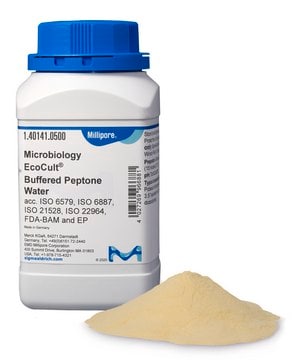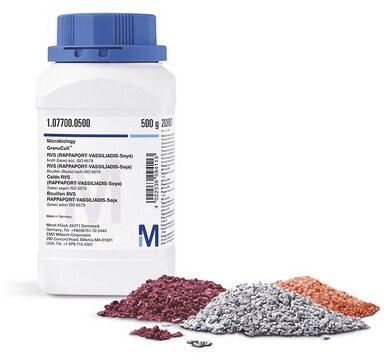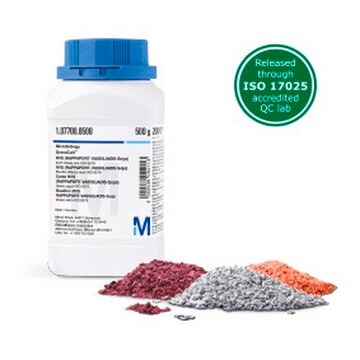1.07228
Buffered Peptone Water
GranuCult® prime, ISO 19250, ISO 6579-1, ISO 21528-1, ISO 22964, FDA-BAM, EP, granular, pkg of 0.5-25 kg
Synonym(s):
BPW, Buffered Peptone Solution, GranuCult® BPW, Peptone Water (buffered), Peptone Water, buffered, Peptone Water, phosphate-buffered, Tryptone Phosphate Water
About This Item
Recommended Products
Agency
APHA
EP
FDA-BAM
ISO 19250
ISO 21528-1
ISO 22964
ISO 6579-1
ISO 6887
Quality Level
sterility
non-sterile
form
granular
packaging
pkg of 0.5-25 kg
manufacturer/tradename
GranuCult® prime
technique(s)
microbiological culture: suitable
pH
7.2 (37 °C, 25 g/L in H2O, after autoclaving)
solubility
25.5 g/L
bulk density
800 kg/m3
application(s)
food and beverages
microbiology
pathogen testing
storage temp.
15-25°C
suitability
Cronobacter spp.
Salmonella spp.
enterobacteriaceae
nonselective for bacteria (preliminary enrichment)
Looking for similar products? Visit Product Comparison Guide
General description
GranuCult® is our new brand name for our existing granulated dehydrated culture media which apply to new EN ISO 11133:2014 and various other ISO standards and FDA-BAM / USDA-FSIS methods for testing of food and water samples. All these media are currently being updated to be fully compliant to the latest version of these standards and regulations with respect to composition and quality control and will be available shortly.
Application
Linkage
Storage and Stability
- Store at +15 °C to +25 °C, dry and tightly closed.
- Do not use clumped or discolored medium.
- Protect from UV light (including sunlight).
- For in vitro use only.
- According to EN ISO/FDIS 6579-1, the self-prepared medium can be stored in closed containers at +2 °C to +8 °C in the dark and protected against evaporation for up to six months.
Analysis Note
Appearance (colour): yellowish
pH-value (25 °C): 6.8 - 7.2
Growth promotion test in accordance with the current version of DIN EN ISO 11133 and the harmonised method of EP, USP and JP.
Inoculum on reference medium (Escherichia coli ATCC 25922 (WDCM 00013)): ≤ 100
Inoculum on reference medium (Escherichia coli ATCC 8739 (WDCM 00012)): ≤ 100
Inoculum on reference medium (Salmonella typhimurium ATCC 14028 (WDCM 00031)): ≤ 100
Inoculum on reference medium (Salmonella enteritidis ATCC 13076 (WDCM 00030)): ≤ 100
Inoculum on reference medium (Salmonella Abony NCTC 6017): ≤ 100
Growth (Escherichia coli ATCC 25922 (WDCM 00013)): good to very good
Growth (Escherichia coli ATCC 8739 (WDCM 00012)): good to very good
Growth (Salmonella typhimurium ATCC 14028 (WDCM 00031)): good to very good
Growth (Salmonella enteritidis ATCC 13076 (WDCM 00030)): good to very good
Growth (Salmonella Abony NCTC 6017): good to very good
Incubation:
18 ± 2 hours at 37 ± 1 °C
S.abony 18 - 24 hours at 30 - 35 °C
Other Notes
Footnote
The designations basic, plus, or prime are added to indicate the quality control level, from basic quality control to standard QC plus to prime for full regulatory compliance.
Legal Information
Storage Class Code
11 - Combustible Solids
WGK
WGK 1
Certificates of Analysis (COA)
Search for Certificates of Analysis (COA) by entering the products Lot/Batch Number. Lot and Batch Numbers can be found on a product’s label following the words ‘Lot’ or ‘Batch’.
Already Own This Product?
Find documentation for the products that you have recently purchased in the Document Library.
Articles
Shigella spp. are predominantly connected to humans and are rarely isolated from other animals, with the exception of primates.
Technical article on Cultivation of Shigella
Salmonella pass through the entire food chain from animal feed, primary production, and into households or food-service establishments.
Protocols
Revised EN ISO 21528:2017 for detection and enumeration of Enterobacteriaceae in the food chain.
The International Organization for Standardization (ISO) has published the new EN ISO 22964:2017 standard, which specifies a horizontal method for the detection of Cronobacter spp. in food, animal feed and environmental samples.
ISO published the new EN ISO 6579-1 standard in 2017, which specifies a horizontal method for the detection of Salmonella spp. in products intended for human consumption, animal feed, and environmental samples in food production and handling.
In recent years it has been recognized that Listeria is an important public health problem. The disease affects primarily people of advanced age, pregnant women, newborns, and adults with weakened immune systems.
Related Content
Food microbiology testing is a key part of the food safety and quality management. Learn more about the wide range of tests covering pathogens and spoilage organisms.
Our team of scientists has experience in all areas of research including Life Science, Material Science, Chemical Synthesis, Chromatography, Analytical and many others.
Contact Technical Service







